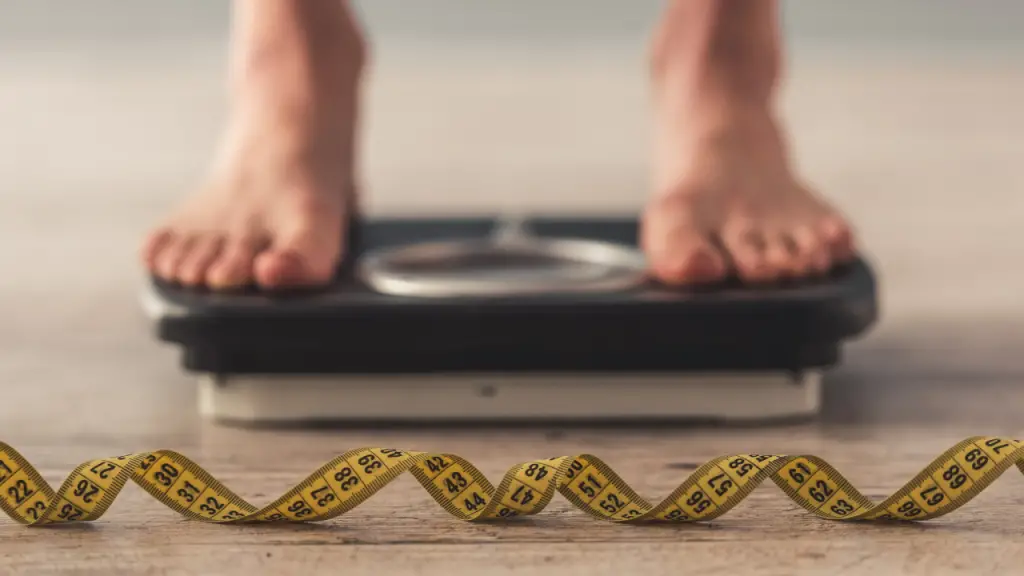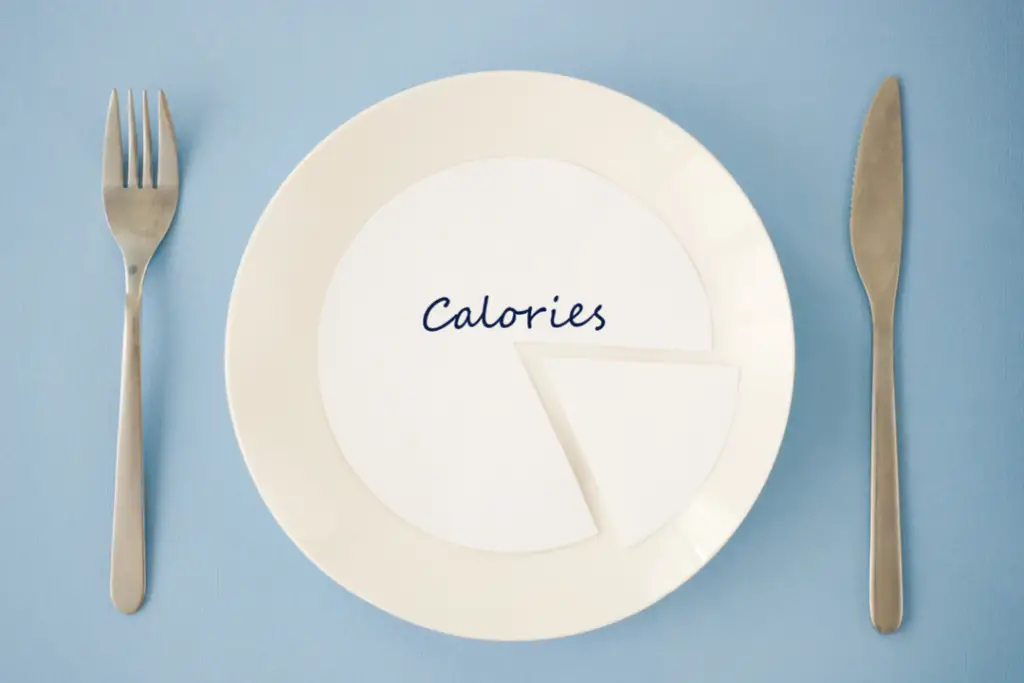Sometimes, it’s helpful to get back to the basics. This is what this post is all about. I decided to give you an overview of everything you need to know to lose weight with intermittent fasting by providing you with an ultimate guide to intermittent fasting for weight loss. It will become the ultimate resource you can refer back to repeatedly as you progress through your weight loss journey.
I will explain intermittent fasting, how it works, and how you can determine if it is an appropriate tool FOR YOU. Then, I will give you my step-by-step protocol for using intermittent fasting for weight loss.
Guide to Intermittent Fasting for Weight Loss
Let’s begin this guide to intermittent fasting for weight loss with the true basics: what intermittent fasting is, how it works, and whether it is an appropriate weight loss tool FOR YOU.
What Is Intermittent Fasting?
As often as possible, I like to remind you that intermittent fasting DOES NOT mean skipping breakfast. Some very influential health experts I admire, such as Dr.Valter Longo, don’t recommend intermittent fasting because they equate it with skipping breakfast. It is such a common misnomer! Dr. Valter Longo explains that intermittent fasting is a stress on your body that will take years off your life and won’t enable you to benefit from ketosis (which the Fasting Mimicking Diet does). However, you can get into ketosis with intermittent fasting. It’s about picking the correct method.

Ways to Practice Intermittent Fasting
If intermittent fasting isn’t about skipping breakfast, then what is it? It’s about eating all your calories within a predetermined eating window. Some people call it time-restricted eating. Say, you decide you will be eating all your calories within a 6-hour window, you could start eating at 8 am and stop at 2 pm. Some intermittent fasting methods even require you to fast for 24 hours twice a week. In this case, you do eat breakfast five days a week! Or, in the case of the 5:2 method, you eat 500 calories on your fasting days. The way you spread out these calories is up to you!
More on how to pick the right intermittent fasting method for you later.
What Breaks a Fast
Fasting experts agree you can drink the following without breaking your fast:
- Black coffee (only two calories a cup): Coffee may even induce autophagy!
- Green, oolong, and black tea (2 calories a cup): Contain calorie restriction mimetics, which induce autophagy.
- Most herbal teas: Make sure they don’t contain additives and fruit.
- Apple cider vinegar (3 calories in 1 Tbsp)
- Stevia: May lower blood sugar and improve metabolic health.
- Carbonated water: Flavored is fine; make sure there are no other additives.
- Lemon juice
You may also be able to have some fatty foods like full-fat coconut milk and MTC oil. Read What Breaks a Fast and What Doesn’t: An Indispensible Guide to learn more.

How to Break a Fast
Whenever you fast for 24 hours or less, you don’t need to worry too much about how you break your fast. Simply pick some whole foods you enjoy! However, I provide additional guidance in my post What to Eat to Break a Fast (Don’t Sweat the Small Stuff).
How Does Intermittent Fasting Work for Weight Loss?
Why is intermittent fasting effective for weight loss? How does it work? Two factors will enable you to lose weight with intermittent fasting: you will become metabolically flexible (reducing your food cravings), and your restricted eating will naturally decrease your calorie intake.
Metabolic Flexibility
If you ever see a guide to intermittent fasting for weight loss that doesn’t mention metabolic flexibility and the metabolic switch enabled when intermittent fasting, know that it is missing a fundamental piece. I see that a lot! Many people misunderstand intermittent fasting, even those who don’t condemn it. They assume weight loss happens only because you eat less.
Technically, metabolic flexibility will reduce your food cravings, making you consume fewer calories, but healing also occurs in your body. Inflammation decreases. You start craving the foods your body needs instead of craving sugar.

How Metabolic Flexibility Works
Becoming metabolically flexible is just another name for fat-adapted. You may have heard of being fat-adapted before. It means your body can easily switch from burning glucose to burning ketones for energy. You must train your body to become metabolically flexible, particularly when you have grown accustomed to eating frequently. I will explain how to train your body when we dive into the steps of intermittent fasting for weight loss.
Fewer Calories
It is evident that confining all your calorie intake within a 4-hour eating window will make it harder to overeat. Consequently, it will naturally decrease your calorie intake.

How to Know If It’s an Appropriate Weight Loss Tool for YOU
As a beginner, you may be hesitant to try intermittent fasting. You have probably heard stories of men and women who wrecked their hormones because of intermittent fasting. While I don’t deny that this may happen, I think that it is likely that other factors interfered with the process. Done right, intermittent fasting is safe for most people. You could compare it to exercise. It is a stress on your body. You can overexercise. However, nobody would ever say that exercise is unhealthy and dangerous.
That being said, you may not need intermittent fasting to reach your health goals. Here are some signs that are likely to mean that becoming metabolically flexible through intermittent fasting is an appropriate weight-loss tool FOR YOU:
- You tend to crave foods overall (particularly sweets after eating a meal).
- Hunger makes you feel miserable rather than just a sensation in your belly.
- You find that eating carbs makes you want to eat more carbs.
Thes signs most likely mean that you need to improve your insulin sensitivity. You will do well with plans that approach learning to listen to your body’s cues and eating whole foods rather than fasting.
Learn more in my Intermittent Fasting 101 Workshop.
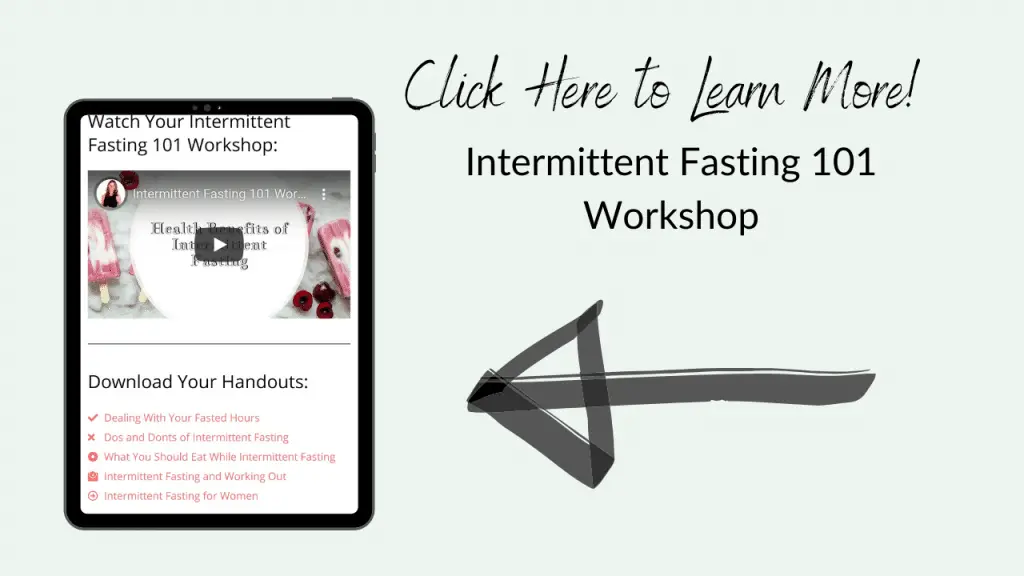
Step-by-Step Formula to Lose Weight With Intermittent Fasting:
No guide to intermittent fasting for weight loss would be complete without a step-by-step formula to implement intermittent fasting successfully.
1. Become Fat-Adapted
Some health experts recommend you start with a shorter fasting window and then slowly lengthen it until you reach 16 hours or so. However, if you are anything like I was, you will find that even a 12-hour fasting window will be hard until you become fat-adapt. That’s why I recommend becoming fat-adapted before experimenting with intermittent fasting.
How to Become Fat-Adapted
I have two favorite ways to become fat-adapted: a 7-day keto cycle or a 5-day modified fast.
7-Day Keto Cycle
The advantage of a keto cycle is that you will not go hungry. The disadvantage is that you will likely experience the keto flu. Try a teaspoon of Himalayan salt in water if you feel sick.
I offer an intermittent fasting keto meal plan that you can use. If you don’t enjoy keto coffee for breakfast, eat eggs or meat instead.
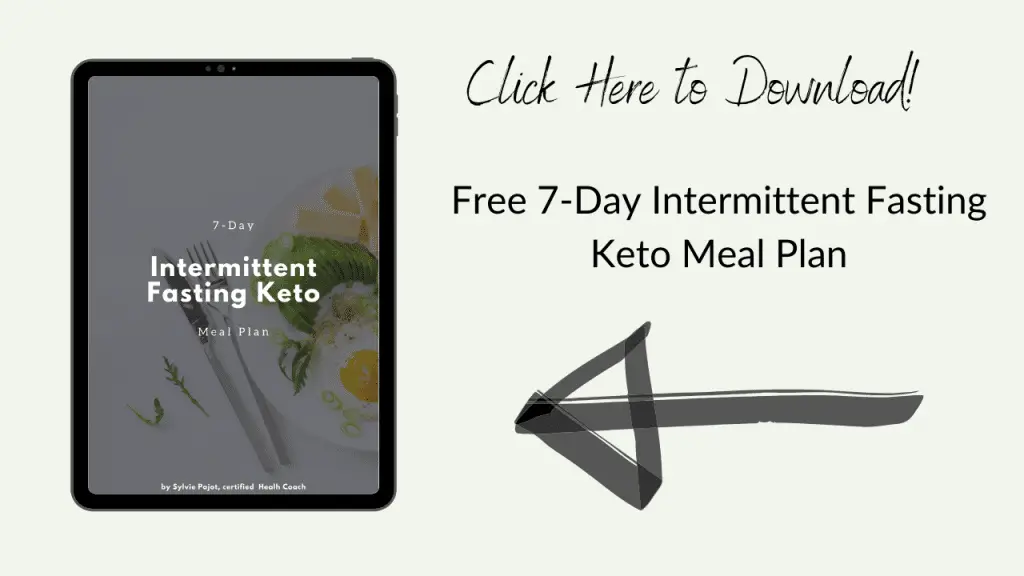
5-Day Modified Fast
A modified fast relies on severe calorie restriction, low protein intake, and low-carb consumption to heal your body through autophagy and get you into that fat-burning mode. It is based on the Fasting Mimicking Diet by Dr Valter Longo.
The main advantage of the modified fast is that it is shorter than seven days, and you won’t experience the keto flu. However, you will probably feel hungry during your 5 days. It would be best to feel confident in overcoming this hunger as you understand the benefits for your body. I offer many DIY meal plans, learn everything you need to know here.

2. Pick Your Fasting Window
After becoming fat-adapted, experimenting with intermittent fasting will be easier. Whenever you fast overnight, your body starts running out of glycogen and using fat cells to produce ketones. At around 28 hours, your body relies on ketones for energy as it has run out of glycogen. Generally speaking, 16 hours is when your body uses more ketones than glycogen. All that to say, you need to fast longer than 16 hours to benefit from ketosis on your fasting days.
Here are the intermittent fasting methods I tend to recommend the most:
- Warrior Diet: fast for 20 hours 4 or 5 days a week.
- Eat-Stop-Eat Method: fast for 24 hours 2 or 3 days a week.
- 5:2 Method: eat 500 calories 2 days a week.
Read How Fasting for 20 Hours Benefits You to learn why I recommend fasting for 20 hours or more.
3. Monitor Your Ketone Levels
Throughout the process of picking your fasting window and readjusting as needed, monitoring your ketone levels can be a helpful tool. On your fasting days, you must ensure that you experience the metabolic switch that occurs when your body uses more ketones than glucose for energy. The primary way to know is that your hunger will feel like a sensation that doesn’t make you miserable. It’s just a feeling in your belly that comes and goes. You will also notice that you feel energetic, and your food cravings decrease (when you become fat-adapted in step one). This “switch” usually happens when your ketones measure about 1.0 to 1.5 mmol/L on a ketone monitor. Seeing those numbers on your monitor is helpful.
I use the Keto Mojo, and you can get a 15 percent discount with my affiliate link.

4. Maintain Your Weight Loss
Now, the god part! You have reached your goal weight after months and possibly a year or two of experimenting with fasting and healing your body through the power of burning fat for fuel on a regular basis. You feel terrific, so you want to keep intermittent fasting without losing more weight. Moreover, you don’t want to waste all your efforts by just returning to eating anytime and gaining the weight you lost. This is what the last step is all about.
You will learn to tune into your body to determine how much fasting you need to maintain.
Signs You Need to Fast More
Whenever you notice that your cravings are returning or if the quality of your sleep is suffering, you may want to try a 24-hour fast. Read Why You Should Try a 24-Hour Fast While and After Losing Weight for more guidance.
Signs You Need to Fast Less
If you have reached your goal and are still losing weight, you have two options: fasting less or eating more during your eating window. I have been experimenting with fasting less for about a year now. Sometimes I eat before 10 am sometimes, I eat at lunchtime and sometimes I eat in the afternoon (particularly when I want to improve my sleep). You don’t always need to do the same thing and follow specific “rules.” Do what feels best on any given day.
If you want additional help to reach your weight loss goals using intermittent fasting, don’t forget to check out my 30-Day Intermittent Fasting Transformation or my coaching packages.
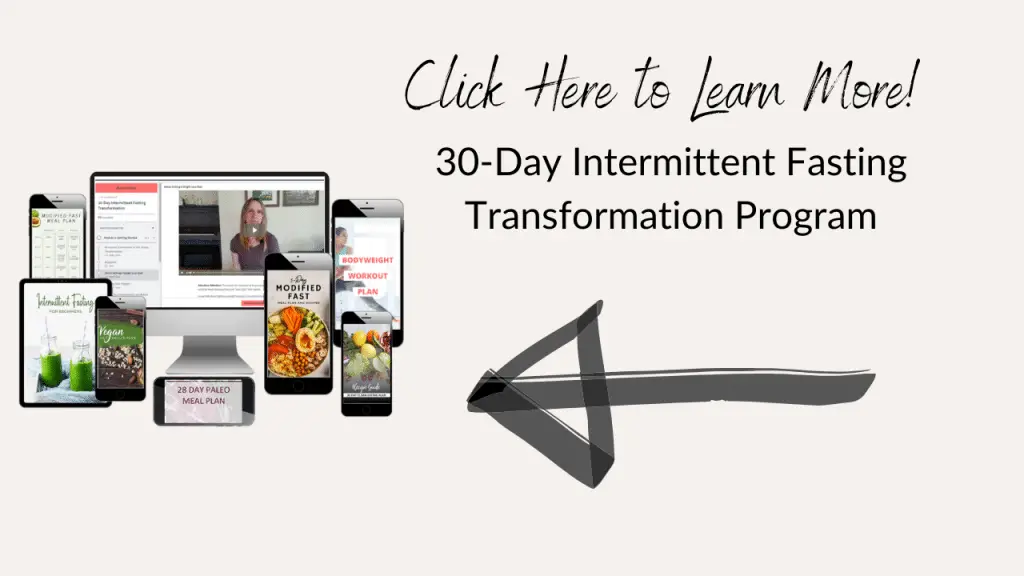
Ultimate Guide to Intermittent Fasting for Weight Loss Video
In Summary
Now, this Ultimate Guide to Intermittent Fasting for Weight Loss was pretty extensive! The key to success in weight loss through intermittent fasting is ensuring that you fast long enough to get in the fat-burning zone (ketosis). Furthermore, avoid fasting every day to enjoy some normal days and not put too much stress on your body. When you simplify it into those two elements, you realize it isn’t too complicated. It’s just a matter of training your body into new patterns that will work for you rather than against you. It’s about breaking the rules and finding what works for YOU!



